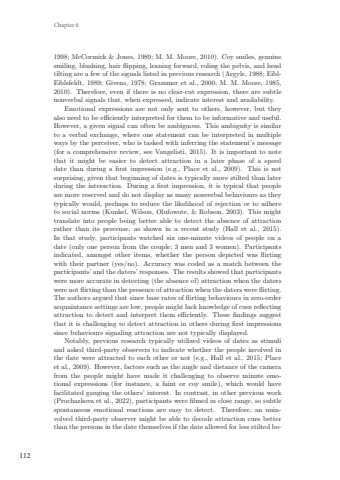Page 114 - Demo
P. 114
112Chapter 61998; McCormick & Jones, 1989; M. M. Moore, 2010). Coy smiles, genuinesmiling, blushing, hair flipping, leaning forward, roling the pelvis, and headtilting are a few of the signals listed in previous research (Argyle, 1988; EiblEiblsfeldt, 1989; Givens, 1978; Grammer et al., 2000; M. M. Moore, 1985,2010). Therefore, even if there is no clear-cut expression, there are subtlenonverbal signals that, when expressed, indicate interest and availability.Emotional expressions are not only sent to others, however, but theyalso need to be efficiently interpreted for them to be informative and useful.However, a given signal can often be ambiguous. This ambiguity is similarto a verbal exchange, where one statement can be interpreted in multipleways by the perceiver, who is tasked with inferring the statement’s message(for a comprehensive review, see Vangelisti, 2015). It is important to notethat it might be easier to detect attraction in a later phase of a speeddate than during a first impression (e.g., Place et al., 2009). This is notsurprising, given that beginning of dates is typically more stilted than laterduring the interaction. During a first impression, it is typical that peopleare more reserved and do not display as many nonverbal behaviours as theytypically would, perhaps to reduce the likelihood of rejection or to adhereto social norms (Kunkel, Wilson, Olufowote, & Robson, 2003). This mighttranslate into people being better able to detect the absence of attractionrather than its precense, as shown in a recent study (Hall et al., 2015).In that study, participants watched six one-minute videos of people on adate (only one person from the couple; 3 men and 3 women). Participantsindicated, amongst other items, whether the person depicted was flirtingwith their partner (yes/no). Accuracy was coded as a match between theparticipants’ and the daters’ responses. The results showed that participantswere more accurate in detecting (the absence of) attraction when the daterswere not flirting than the presence of attraction when the daters were flirting.The authors argued that since base rates of flirting behaviours in zero-orderacquaintance settings are low, people might lack knowledge of cues reflectingattraction to detect and interpret them efficiently. These findings suggestthat it is challenging to detect attraction in others during first impressionssince behaviours signaling attraction are not typically displayed.Notably, previous research typically utilized videos of dates as stimuliand asked third-party observers to indicate whether the people involved inthe date were attracted to each other or not (e.g., Hall et al., 2015; Placeet al., 2009). However, factors such as the angle and distance of the camerafrom the people might have made it challenging to observe minute emotional expressions (for instance, a faint or coy smile), which would havefacilitated gauging the others’ interest. In contrast, in other previous work(Prochazkova et al., 2022), participants were filmed in close range, so subtlespontaneous emotional reactions are easy to detect. Therefore, an uninvolved third-party observer might be able to decode attraction cues betterthan the persons in the date themselves if the date allowed for less stilted beIliana Samara 17x24.indd 112 08-04-2024 16:36


